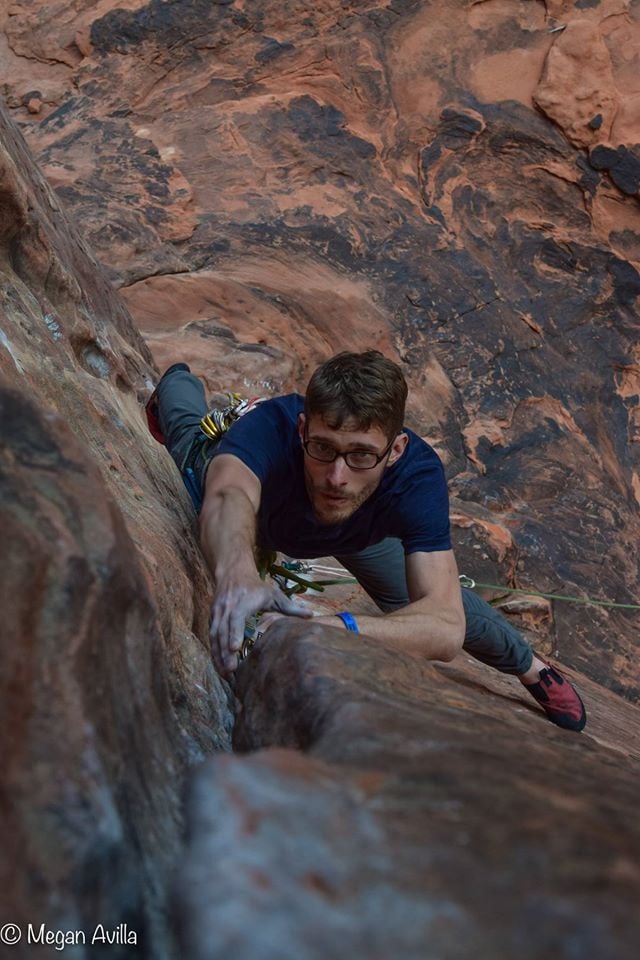An Introduction into Core Tension
What Is Core Tension?
Imagine that you’re standing in front of a table with a nice, smooth surface. On the table is a small coin. In your hand is a piece of uncooked spaghetti. Your goal is to hold the piece of spaghetti and use it to slide the coin around on the table – push the coin away, pull it back towards you, slide it left and right etc. While you might need to be careful, you can definitely do this.
Now, imagine that a small section in the middle of the spaghetti you're holding suddenly becomes cooked. What would happen when you try to move the coin around now? Every time you try to push the coin with the spaghetti, the spaghetti just bends in the middle and you aren’t actually able to exert much force on the coin itself. While you might still be able to move it around a little, this will be more difficult and less precise that when the spaghetti was completely uncooked.
Why Core Tension Matters
When we’re climbing, pushing and pulling on holds, we are like the piece of spaghetti. If our body stays strong from end to end (fingers to toes), then we can push, pull, and move very well. However, climbing becomes much more difficult if a small part of that chain loses strength. This is where core tension comes in. Core tension is the ability to maintain enough muscle activation in the trunk of our body - our glutes, hips, stomach, sides, back, etc. - so that we can stay in position and effectively push and pull with our limbs.
When to use Core Tension
The amount of core tension we need while climbing varies widely, but nearly every situation on the wall requires at least some core tension. As a very general rule, the further away our body gets from being in its a normal standing position (I.e. vertical, with feet under hips under shoulders), or the more we try to exert forces that aren’t directly downwards, the more core tension we will need to maintain that position or move into or out of it. For example, standing on a slab might require relatively little core tension, while climbing on a roof or steep overhand requires a lot of core tension to keep our hips from sagging away from the wall like a cooked noodle.
Check out this video of our setters in Hampden trying an overhanging problem while not holding their body tight vs. when they activate their core.
So to sum it up...
It’s worth taking time to improve our use of core tension! Just remember the difference between the cooked and uncooked noodle. Improving use of core tension allows us to more fully utilize our strength, climb more efficiently, creates a foundation for performing more complex climbing movements, and lowers our risk of injury.
Core Tension is More than Strength
To become more effective at using core tension on the wall, we need to train three key skills - one physical, one mental, and one tactical. It’s tempting to focus on just one of these, but we really need to train all three together in order to feel growth. The good news is we can train all three skills at once during a simple at-home workout. To get started, read about these three skills below and try the exercises at the end of this article!
- Physical: Improve your physical ability to create core tension. To use core tension on the wall you need a strong core. However, that’s not enough. You need a core that is mobile and strong throughout your range of motion, that reacts quickly to stabilize against forces applied from any direction, and that endures repeated cycles of high tension and relaxation for the duration of the climb. If that’s not enough, you also need a core that is highly coordinated, so you can activate the right muscles in the right order at the right time to create the movements you want.
- Mental: Improve your ability to focus on core tension while distracted. Strength only works if you use it. Some moves require so much tension, that to do them we need to consciously focus on maintaining tension before, during, and after the movement. A split-second lapse of focus can lead to a split-second lapse in tension. A split-second lapse in tension is enough to make our foot slip, or to change our center of gravity and pull us off the wall. In short, to effectively apply our physical core strength we also need unwavering mental focus.
So many factors demand our mental focus while climbing: Fear, uncertainty, fatigue, remembering beta, and processing all sorts of information to make minor on-the-fly adjustments. We can’t just let go of all this to focus exclusively on core tension. Instead, we need to systematically train ourselves so that creating and maintaining core tension takes less and less conscious effort. - Tactical: Expand your sequencing habits to include your core. Sequencing is often thought of as deciphering and memorizing the hand, foot, and body movements of a climb. However, beyond just knowing where our hands and feet go, we need to know what the climb feels like. When sequencing a climb imagine you are building a mental sparring partner – one that you can rehearse with in your head to prepare for battling the climb itself. The more fleshed out and detailed the sequence feels, the more effectively the visualization will prepare you for the climb itself.
One of the key elements is visualizing how movements will feel in our core – where will we need core tension? In what parts of our core? How will that tension extend through our legs down to the tip of our toes, and through our shoulders and arms down to our fingertips? What will all that tension feel like? As we run through our sequence on the ground, miming our hand and body movements, we need to add in that core tension! Taking time on the ground to coordinate body movements with the required core tension lets us perform more consistently and intuitively on the wall.
Core Tension Workout
So, to practice core tension on your own, try the exercises below. To get the most out of these it’s not just about what you do, but how you do it. Here are some pointers to help you train all three aspects of core tension while you exercise. To get extra benefits and notice when your core tension lapses you can record yourself on video – any shift in balance, sagging of your hips or lower back, or change in posture often reveals a loss of core tension that you may not have noticed.
Things to remember during these exercises
- Physical - Actively create tension: Focus on lengthening your spine from the crown of your head to your heels, and pressing into the floor with all four points of contact (hands and toes). Remember and repeat this every time you return back to your plank position. This helps maintain alignment and a high level of core tension as you exercise.
- Mental – Keep constant pressure through fingers and toes: As you move throughout each exercise try to keep the amount of pressure you’re applying to the ground through your hands and toes constant and balanced. For example, while in your starting plank position, feel the amount of pressure you’re applying to the ground through your left toes, and notice that your weight is distributed evenly across all four points of contact. Now, try to maintain the same pressure as you move, and try to keep the direction of pressure the same. Our tendency is to shift our weight onto one side or the other, or to release tension as we get distracted by performing the movements. However, the goal here is to fight this urge, and train ourselves to maintain consistent core tension! Think of this as training for climbing: If we suddenly shift weight or decrease pressure through our toes while climbing our feet slip or we feel the cooked noodle effect and fall!
- Tactical – Visualize before starting and between sets: Before starting your first set, and between each set, visualize how each exercise will feel in your core. How difficult will it be? What part(s) of your core will feel most strained? Bonus points for actually miming the motions and core tension while standing! While it may feel silly, this will help you practice visualize the core tension you need for actual climbing movements.
The Exercises
Before exercising make sure to warm up thoroughly, especially your hips, shoulders, and wrists! To get the most out of these exercises, do this on a hard floor (wood or tile) while wearing socks or placing your feet on small towels. This will let your toes slide across the floor, similar to using TRX straps. Do each exercise 5-10 times, then move to the next.
Warm-Up: Hollow body hold
The key to the hollow body hold is ensuring that your lower back is pressed to the ground throughout the duration of the exercise. This act of pushing your lower back into the ground requires you to flex your abdominal muscles, which is why this is a great warm up.
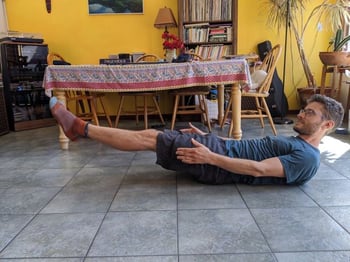
Exercise 1: Slide outs (bent arm is easier, or straight arm is harder)
- Start off in a plank-like position (Core-tip: for an easier variation, start on your elbows. For a harder exercise, start off with straight arms)
- Keeping your hands where they ares, slowly slide your toes back behind you
- Slowly use your core to bring your toes back to the original start position
- Repeat 5-10 times
Easier variation on elbows
.jpg?width=350&name=Slide%20Outs%20on%20Elbows%20(1%20of%202).jpg)
.jpg?width=350&name=Slide%20Outs%20on%20Elbows%20(2%20of%202).jpg)
Harder variation on arms
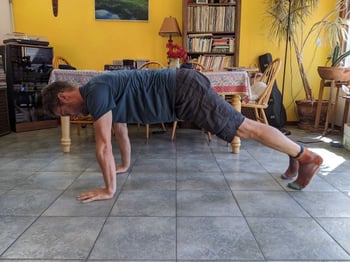
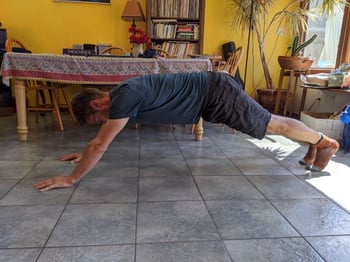
Exercise 2: Knees to elbows with sliders
- Start in a plank position
- Starting with your right leg, bring your right knee to your right elbow. Hold for a second
- Bring your leg back to return to a plank position
- Repeat with your left knee/elbow
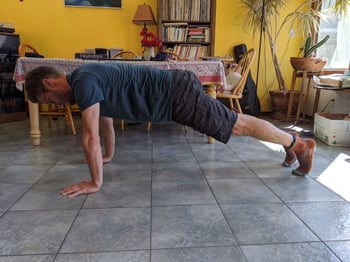
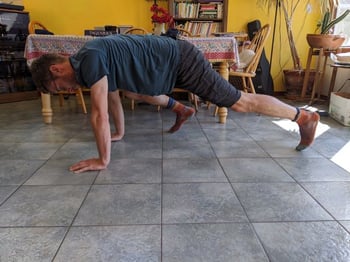
Exercise 3: Bird dogs (on hands and knees is easier, on hands and toes is harder)
- Start in on your hands and knees, with your back in a neutral position. For a harder variation, start in a plank position.
- Slowly extend your right leg and your left arm and hold for a second
- Return to your start position
- Repeat with your left leg/right elbow
Easier variation on hands and knees
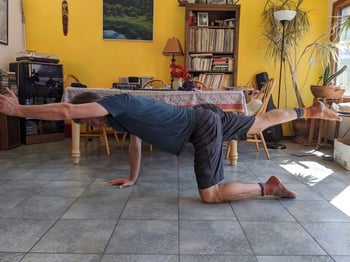
Harder variation on hands and toes

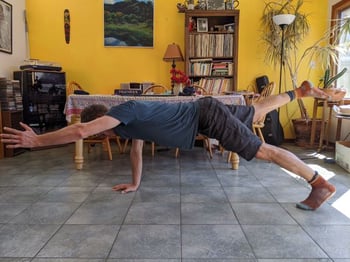
Rest 2-3 min.
Final Form: A core tension flow!
Link all the exercises together into a flow. Do one rep of the first exercise, then progress smoothly into one rep of the second, and so on. Repeat the whole flow 5-10 times before resting. Transitioning between these movements often makes the exercise feel a little easier physically since you aren’t isolating any one area of your body quite as much. However, this is often harder mentally, since you transition more quickly between a wider range of body positions which makes it more challenging to stay focused on keeping constant tension.
Come join us for a climb. Find a Movement Gym near you.
About Jesse
My name is Jesse, and I’m the Regional Assistant Director of Programs in the Bay Area, CA. I have been climbing since 2006, and working at Movement since 2014 as a coach, program manager, and private instructor. I have been lucky enough to work with many amazing coaches and athletes in and outside of Movement, ranging from brand new climbers and coaches to individuals coaching and competing at the national level. I’m still learning, and love being surrounded by coworkers who are passionate and excited to share their knowledge. Photo Credit: Megan Avila


